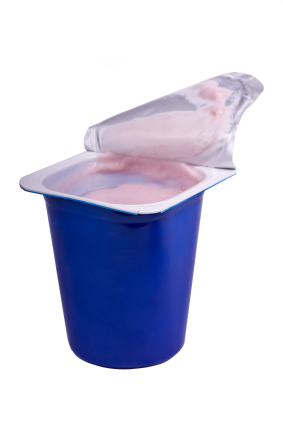 Yogurt has deep roots. It has been enjoyed in many cultures for a long part of history. It is traditionally made by adding milk and a small amount of a yogurt starter culture together and incubating it for several hours within a specific temperature range.
Yogurt has deep roots. It has been enjoyed in many cultures for a long part of history. It is traditionally made by adding milk and a small amount of a yogurt starter culture together and incubating it for several hours within a specific temperature range.
This type of yogurt is a delicious staple in many kitchens around the world! Many cultures consume yogurt as a condiment or as an accompaniment to spicy foods.
In western cultures, yogurt is considered to be a delicious health food with beneficial bacteria that aids digestion and satisfies cravings without any guilt. Greek yogurt is a popular choice among the health conscious because the whey has been strained out and what’s left is a creamy and protein rich treat.
People in the west are also becoming increasingly aware of the potential health benefits that enjoying fermented foods, such as yogurt, may have. Probiotics and foods containing probiotics are quickly becoming a mainstream trend and yogurt is at the forefront of this movement.
Unfortunately, there is a disparity between the yogurt made through traditional methods and the carton of key lime pie flavored (and any other flavored variety) non-fat yogurt that is ubiquitous on the shelves of the typical grocery store.
3 Reasons You Should Not Eat Most Yogurt
Probiotics – It may be true that there are beneficial probiotics in commercially produced yogurt but any dairy products available at grocery stores have undergone pasteurization at high temperatures which is a process that beneficial bacteria cannot survive. Therefore, the probiotics are likely added to the yogurt after it has been pasteurized rather than allowing the natural fermentation process to produce the bacteria inherent to the yogurt culture. Some manufacturers add specific strains of probiotics that they believe is most beneficial for consumers.
In theory, this is a good idea, but these manufacturers do not take into account that different people may need different strains of probiotics. Therefore, you may not be eating the yogurt that has the good bacteria that your individual system needs, even though you believe you are doing something healthy. Even though the added probiotics in yogurt at the grocery store may be somewhat beneficial among some consumers, they typically come at a high cost to your health…
Sugar – The problem with these store-bought yogurts is that most of them, especially the alluring ones, are loaded with sugar. How often do you see a yogurt product that sounds too good to be true? The labels read like a decadent dessert menu at a fancy restaurant….Key lime pie, triple berry torte, and red velvet cake. These flavored yogurts claim to be healthy by using the target words “low-fat” or “light” to entice you, but fail to overtly mention the large amount of sugar that exists in place of the fat that was removed. Flavored nonfat or low-fat yogurts sometimes contain up to 25 to 30 grams of added sugar per serving.
Experts on sugar intake suggest that 50 grams of added sugar is the maximum amount individuals should consume on a daily basis. This means that these yogurts may contain half the amount of the sugar that you should ideally consume per day.
Consider that the calories are usually under 200 per serving of yogurt and you can see that the sugar content is way too high for a reasonable daily caloric intake of 2000 calories. Now it’s clear that these sugary yogurts are not going to help you with your goals of eating healthy, even though their advertisements and labels claim to do just that.
Fruits – You should not only consider the amount of sugar that these yogurts have, but you should also know that the fruits that are frequently swimming in the bottom of your yogurt cup may not be very fresh. The fruit used in these processed yogurts is often chosen because the quality is not good enough to be sold fresh. If the fruit isn’t fresh there is a chance it could become toxic which will make the yogurt toxic as well. Fruit that is past its expiration can produce mycotoxins, which can be harmful to those who consume it. Unfortunately, this is not information that you will find on the label of your favorite fruity yogurt.
But there’s even more to consider about these yogurts…
What if you choose to buy the plain non-fat yogurt that doesn’t have any added fruit or sweet flavors?
Well, the sugar intake is going to be less, which is a good thing, but the fat that was taken away may actually be healthy fat for you! We usually believe that non-fat or low-fat products are the healthiest because we correlate low-fat in a food to mean less fat on our bodies or in our arteries.
This is not always the case, especially when choosing something with saturated fat. Saturated fat actually helps your body to absorb some nutrients and can be very healthful in moderation. In addition, non-fat yogurt is heavily processed and is no longer as healthy because they it is not a whole food.
What Yogurt Should You Buy?
Fortunately, there are better options for those of us who want to eat healthy and avoid a lot of damaging foods that are marketed as good for us. If you enjoy the different types of yogurt that you find at the grocery store, it is best to buy the ones that offer the most benefits and the least amount of consequence. This is easy now that you know what to avoid.
Find yogurts that are made from 2% or whole milk because they’ve gone through less processing and are closer to their whole, natural form. Skip the sugar and the added fruit and opt instead for plain Greek yogurt or unsweetened plain yogurt. You can add fresh organic fruit and more nutritious sweeteners, such as honey or stevia leaf extract, to your yogurt.
Other Alternatives?
 Another alternative to replace sugary yogurt products is kefir, which has a similar flavor to yogurt but is a drink. Kefir has even more probiotics than yogurt and can really add delicious flavor to a smoothie with your favorite organic fruits. The probiotics in kefir actually aid your body to have healthy digestion and may help heal your gastrointestinal disorders.
Another alternative to replace sugary yogurt products is kefir, which has a similar flavor to yogurt but is a drink. Kefir has even more probiotics than yogurt and can really add delicious flavor to a smoothie with your favorite organic fruits. The probiotics in kefir actually aid your body to have healthy digestion and may help heal your gastrointestinal disorders.
These probiotics are different than the ones in yogurt because they recolonize the gut with beneficial flora, whereas yogurt probiotics just pass through your system. You can buy kefir at health food stores and some grocery stores, but for an even healthier beverage you might want to try making it yourself. You can easily find kefir grains online to which you add milk and then ferment for approximately 15 to 24 hours.
If possible, I recommend finding a great source of local raw milk that comes from grass fed cows in order to make your kefir. Because raw milk hasn’t been pasteurized it has a higher nutrient content and is still in its whole food form! If you don’t have raw milk available, choose a lightly pasteurized organic whole milk for making kefir. You can drink kefir every day and reap the benefits!
It’s certainly confusing trying to figure out what food is best for you especially with all of the misleading marketing in the world today. But once you begin to tune into what is healthy for your body and you understand that real, whole foods are best, it’s easier to break free from this dilemma. Being aware of food trends and reading the actual ingredients on the foods you buy enables you to make great choices for yourself and your family.
If you are eating yogurt because of digestive problems, instead of eating yogurt, you need to know what exactly causes your digestive issues, find out more in the following page –
About the Author:
Emma Deangela is the best selling author of The Alkaline Diet Program and 80/20 Fat Loss. She has helped over tens of thousands of men and women to lose weight and transform their health with sound nutrition advice.
Which wonderful friends in your life would appreciate this information about yogurt? Are they eating the better yogurt?
Please help them by sharing this eye-opening article with each of them using any of the social media and email buttons below.


Leave a Reply